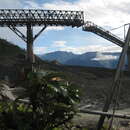fr
noms dans le fil d’Ariane


Ficus dammaropsis (lat. Ficus dammaropsis) — tutkimilər fəsiləsinin əncir cinsinə aid bitki növü.
Ficus dammaropsis, called kapiak in Tok Pisin, is a tropical fig tree with huge pleated leaves 60 cm (24 in) across and up to 90 cm (3 feet) in length.[1] on petioles as much as thirteen inches (32 centimeters) long and one inch (2.5 cm) thick. These emerge from a stipular sheath up to fourteen inches ( 38 cm) long, the largest of any Dicot. It is native to the highlands and highlands fringe of New Guinea. It generally grows at altitudes of between 850 and 2,750 metres (2,790 and 9,020 ft). Its fruit, the world's largest figs (syconia), up to six inches (15 centimeters) in diameter, are edible but rarely eaten except as an emergency food. They are pollinated by the tiny wasp Ceratosolon abnormis.[2] The young leaves are pickled or cooked and eaten as a vegetable with pig meat by highlanders.[3]
The lowland form of this species found commonly below 900 meters is recognized as a distinct species, Ficus brusii.
The species can be found at the Melbourne Botanic Gardens, located in the ‘Yucca Bed’.[4]
With its bold tropical leaves and relative tolerance of cold, F. dammaropsis is cultivated as an ornamental tree in frost-free climates.
 A young highland breadfruit, centre, in Whangarei, New Zealand
A young highland breadfruit, centre, in Whangarei, New Zealand Immature fruits at Royal Botanic Gardens Victoria
Immature fruits at Royal Botanic Gardens Victoria  Syconia (fruit) of the plant Ficus dammaropsis.
Syconia (fruit) of the plant Ficus dammaropsis. Ficus dammaropsis, called kapiak in Tok Pisin, is a tropical fig tree with huge pleated leaves 60 cm (24 in) across and up to 90 cm (3 feet) in length. on petioles as much as thirteen inches (32 centimeters) long and one inch (2.5 cm) thick. These emerge from a stipular sheath up to fourteen inches ( 38 cm) long, the largest of any Dicot. It is native to the highlands and highlands fringe of New Guinea. It generally grows at altitudes of between 850 and 2,750 metres (2,790 and 9,020 ft). Its fruit, the world's largest figs (syconia), up to six inches (15 centimeters) in diameter, are edible but rarely eaten except as an emergency food. They are pollinated by the tiny wasp Ceratosolon abnormis. The young leaves are pickled or cooked and eaten as a vegetable with pig meat by highlanders.
The lowland form of this species found commonly below 900 meters is recognized as a distinct species, Ficus brusii.
The species can be found at the Melbourne Botanic Gardens, located in the ‘Yucca Bed’.
Ficus dammaropsis là một loài thực vật có hoa trong họ Moraceae. Loài này được Diels mô tả khoa học đầu tiên năm 1935.[1]
Ficus dammaropsis là một loài thực vật có hoa trong họ Moraceae. Loài này được Diels mô tả khoa học đầu tiên năm 1935.